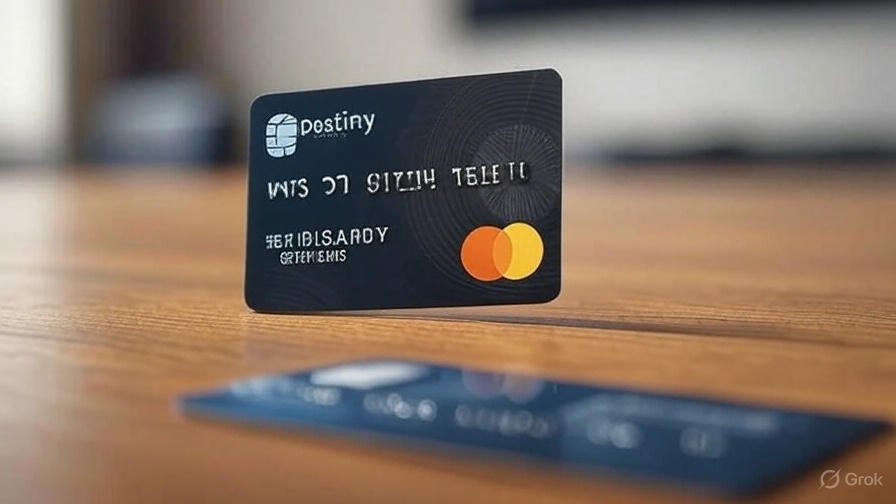In 2025, Destiny credit card reviews are making waves as a go-to for credit rebuilding. First Electronic Bank, via Concora Credit, offers this unsecured card to those with poor or limited credit. This news article brings the latest insights, covering features, benefits, drawbacks, and user experiences. Use this information to guide your financial decisions effectively.
What Sets the Destiny Credit Card Apart?
The Destiny credit card operates on the Mastercard network, targeting individuals with scores of 500 to 600. It skips the deposit requirement, unlike secured cards, offering instant credit. Recent Destiny credit card reviews praise its role for subprime borrowers aiming to enhance their credit.
Concora Credit ensures payment activity reports to Equifax, Experian, and TransUnion. This boosts credit scores with responsible use. However, high fees and rates require careful handling. Learn more about credit scores from Experian Credit Education.
2025 Highlights from Destiny Credit Card Reviews
The latest Destiny credit card reviews reflect its place in a growing market. Experian data shows credit card debt hit $1.13 trillion in Q1 2025, highlighting demand. First Electronic Bank maintains the card’s structure, with no major changes reported.
User feedback suggests limit increases for consistent payers. This adaptability keeps it relevant amid Visa and Mastercard dominance. Stay ahead with these updates.
Key Features Unveiled
Based on current reviews, here are the card’s key attributes:
- Unsecured Access: No deposit needed for immediate credit.
- Credit Limits: Starts at $300 to $1,000 based on your profile.
- Bureau Reporting: Payments report to all three credit bureaus.
- Annual Fee: Ranges from $59 to $175 depending on terms.
- APR: Set at 35.99%, typical for subprime cards.
- Extra Costs: Includes $40 late fees and other charges.
These features aid credit rebuilding but spark cost-related debates among users. Explore unsecured card options at the Consumer Financial Protection Bureau.
Advantages Noted in Reviews
User insights in reviews highlight these strengths:
- Accessible Approval: Open to scores as low as 500.
- Credit Growth: Timely payments improve scores across bureaus.
- No Deposit: Saves cash compared to secured options.
- Global Use: Mastercard acceptance spans millions of locations.
“This card empowers those shut out of mainstream credit,” says Dr. Laura Bennett, a credit specialist. “Its reporting feature rewards diligent users.”
Challenges Identified
Despite benefits, reviews note these drawbacks:
- High Fees: Up to $175 annually and 35.99% APR burden budgets.
- Low Limits: Starting at $300 risks high utilization if unmanaged.
- No Rewards: Lacks cashback or incentive programs.
- Additional Charges: Late fees and cash advances add costs.
Bennett warns, “High costs may deter those eligible for cheaper secured cards.” Consider this before committing.
Real User Feedback
User experiences shape reviews. One user said, “Approved at 540. After a year, my score reached 620 despite high fees.” Another remarked, “The $175 fee stings, but it built my credit.”
Online trends favor short-term use. Many suggest switching to cards like Capital One Platinum at 620–680. This reflects its niche utility.
Who Should Choose This Card?
The card fits these profiles:
- People with scores below 600 rejected by traditional lenders.
- Those dedicated to on-time payments and low balances.
- Users preferring unsecured over deposited cards.
Those with fair credit (650+) may benefit from secured cards or credit union options with better terms.
Expert Tips for Success
Maximize this card with these expert tips from Bennett:
- Pay Fully: Clear balances monthly to avoid interest.
- Limit Spending: Keep usage below 30% of your limit.
- Track Fees: Set reminders to dodge late charges.
- Monitor Scores: Use Credit Karma for progress updates.
These steps ensure the card supports your financial goals.
Alternatives to Consider
Explore these 2025 alternatives based on reviews:
- Discover it Secured: Requires a deposit but offers cashback and no fee.
- Capital One Platinum Secured: Features low fees with limit growth potential.
- Credit Union Cards: Provide customized terms for members.
Comparing options helps align your choice with financial needs.
Credit Score Impact
The card influences scores via bureau reporting. On-time payments build positive history. High utilization over 30% of the limit can lower it.
Users recommend monthly utilization checks. The card’s reporting to all bureaus magnifies its effect, making management vital.
Frequently Asked Questions
Is the Destiny credit card worth it?
It suits those with poor credit for short-term use. High fees limit long-term value.
How does it help my credit?
It reports payments to all bureaus, boosting scores with responsible use.
What are its main drawbacks?
High fees, a 35.99% APR, and low limits top concerns in reviews.
Conclusion
The 2025 Destiny credit card reviews showcase a card for subprime borrowers. It offers credit without a deposit and aids score improvement. High costs and low limits require strategic use.
It serves as a credit-building tool. Compare alternatives and manage wisely. Learn more to see if it fits your goals.
